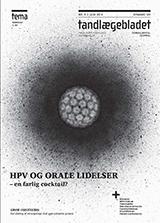Serious forms of candida infections - invasive candidiasis and recurrent oral candidiasis refractory for therapy
Invasive candidiasis and candidaemia are the most serious forms of candidiasis, and the treatment of these infections is handled in hospitals. The incidence of candidaemia is signifi- cantly higher in Denmark than in the other Nordic countries. Calculation of the burden of fungal infections in Denmark has shown that about 900,000 Danes have a fungal infection per year, of which 800,000 are skin infections. In 2013, about 53,000 patients received prescribed antifungal agents for use in the oral cavity, which corresponds to approximately 1% of the population. About half the population is carrier of Candida albicans, and it is the carriers who develop oral can- didiasis. The dentist can carry out the treatment of uncom- plicated cases of oral candidiasis, i.e. cases where the cause is evident, for example, broad-spectrum antibiotic treatment, insufficient oral and/or denture hygiene, reduced salivary se- cretion, and smoking. Treatment becomes more complicated in cases when an underlying disease or condition causes re- current and often refractory oral candidiasis. In such cases a multidisciplinary approach and cooperation is necessary. In order to achieve an optimal response to therapy, it is important to identify factors that are important for therapy selection and duration of treatment. These factors include patient sensitive and infection sensitive parameters as it is important to address the predisposing factors and interven- tion approaches that are needed concurrently with antifungal therapy. Follow up on the therapeutic response is required to minimize resistance development. This article deals with the serious and intractable recurrent candida infections.
Alvorlige candidainfektioner – invasiv candidiasis og behandlingsrefraktær, recidiverende oral candidiasis
ABSTRACT
Profund candidiasis og candidæmi er de alvorligste former for candidainfektion, og behandling af disse sker i hospitalsregi. Incidensen af candidæmi er væsentligt højere i Danmark end i de øvrige nordiske lande. Beregning af forekomsten af svampeinfektioner i Danmark har vist, at omkring 900.000 danskere har svampeinfektion årligt, og heraf udgør hudinfektioner 800.000. I 2013 fik omkring 53.000 patienter ordineret lokale antimykotika til brug i mundhulen, hvilket svarer til ca. 1 % af befolkningen. Omkring halvdelen af befolkningen bærer Candida albicans, og det er bærerne, der udvikler oral candidiasis. Tandlægen kan varetage behandling af ukomplicerede tilfælde af oral candidiasis, dvs. i de tilfælde hvor årsagen er umid- delbar, fx bredspektret antibiotikabehandling, insufficient mund- og/eller protesehygiejne, nedsat spytsekretion og rygning. Behandlingen er imidlertid mere kompliceret, når underliggende sygdom er årsag til recidiverende og ofte behandlingsrefraktær oral candidiasis. Her kan multidisciplinært samarbejde være nødvendigt. For at opnå et optimalt behandlingsrespons er det vigtigt at identificere faktorer, der har betydning for terapivalg og behandlingsvarighed. Det drejer sig om patient- og infektionsrelaterede parametre, da det er af central betydning at adressere prædisponerende faktorer og intervenere samtidigt med antimykotisk behandling. Efterfølgende kontrol af behandlingsresultatet påkræves for bl.a. at minimere resistensudvikling. Denne artikel omhandler de alvorlige og svært behandlelige recidiverende candidainfektioner.

